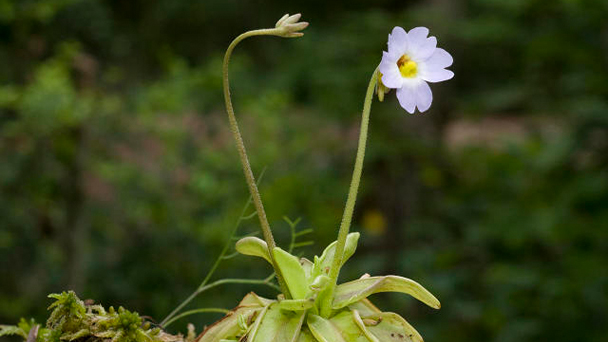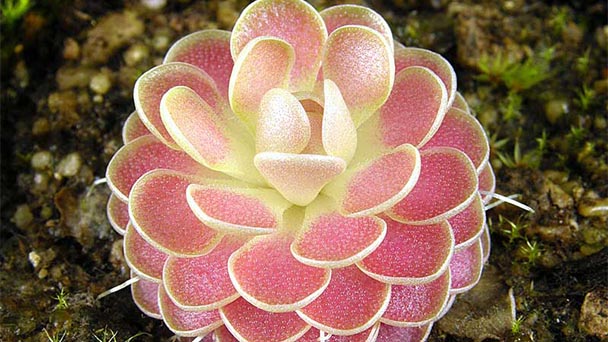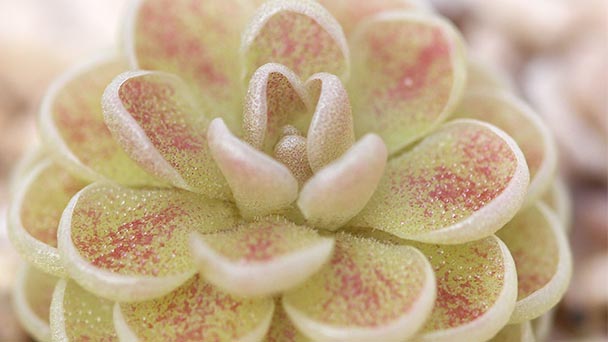Butterwort Profile
Written by Joy
Sep 27 2020

The worm-catching violets are a genus of bladderworts of the order Lamniformes. They are all insectivore plants of about 83 species distributed in the north temperate zone, including Europe, Asia and America. Herbs perennial, root fibrous. Rhizomes are usually short and thick. Insect traps do not exist. Leaf blade is normally elliptic or oblong, margin whole and how many inside roll, green, crisp and tender succulent, above densely secreted mucous glandular hair, can stick catch small insects.


Butterwort morphological characteristics
Perennial herbs, its root is fibrous. Rhizomes are usually short and thick. Basal leaves are rosettes, no stipules. Leaf blade is elliptic or oblong, margin whole and how many inside roll, green, crisp and tender succulent, above densely secreted mucous glandular hair. It can stick catch small insects. Flowers are solitary, pedicels 1-8, long and erect. Calyx two-lip, persistent and somewhat enlarged, upper lip 3-lobed, lower lip 2-lobed. Corolla has two lip-shaped, purple, blue, pink, white or yellow; Upper lip 2 cleft, often shorter than lower lip, lower lip 3 cleft, larynx open. Seeds are numerous, ellipsoidal or long-globose, fine, seed leather with reticulonodular protuberance, sometimes finelike at both ends.Butterwort growth habit and growing environment and distribution
Regarding southern Europe as the center, it is distributed around the world, with Mexico and European regions having the most varieties, which are distributed in the temperate zone of the northern hemisphere and the alpine regions of central and South America. Most of them are born on the wet rock walls of high mountains, while some are born in wetlands and swamps. Distributed in the north temperate zone, including Europe, Asia and America. They all like bright light, and most of them can survive at 2-35 ℃. Catching the pansy species can be more widely distributed, planting requirements are also different, generally it like bright light, and can not be exposed to the sun, afraid of heat, most need alkaline substrate. Some varieties can withstand low temperatures of 0℃ or high temperature of 38℃.Butterwort cultivation
General insect-catching pansy need cross-pollination in order to seed, can choose flowers flowering two days or so, with toothpicks and other instruments adhere to the pollen smears on the stigma of another flower, such as the success of pollination generally 1-2 months after the capsule mature dehiscence, scattered small seeds. Seeding can be done directly on a clean substrate surface, keeping high humidity and bright light for about a month to germinate. Seeds from some temperate species need to be refrigerated for a winter to germinate, and the same effect can be achieved by refrigerating them.Latest Updated
- Benefits of Bugleweed - 7 Science-backed Health Benefits
- Bugleweed Dangers & Side Effects - Is It Poisonous?
- How to Plant Evergreen Trees - What You Should Know
- When to Plant Evergreens - Grow Guide for Evergreen Trees
- 12 Wonderful Evergreen Shrubs for Your Garden
- 12 Popular Evergreen Plants with Pictures for Beginners
- When And How To Prune A Lilac Bush Like a Pro
- How to Grow & Care for Lilac Vine (Hardenbergia Violacea)
- Japanese Lilac Tree (Syringa Reticulata) Care & Propagation Guide
- Shumard Oak Pros and Cons - What to Know
Popular Articles
- Winter maintenance of Antirrhinum Majus
- How to Grow Terminalia Mantaly Tree
- How to Grow and Care for Crossostephium Chinense
- How to grow Antirrhinum Majus in spring
- Peristeria Elata (Dove Orchid) Profile: Info & Care Guide
- Underwatered Snake Plant (Sansevieria Trifasciata) - Signs And How To Fix
- How to Care for Brazilian Jasmine Plant (Mandevilla Sanderi)
- How to Grow & Care for Graptopetalum Purple Delight in Summer
- Rosa Chinensis (China Rose): Plant Growing & Care Tips
- How to Care for Baby Sun Rose (Aptenia Cordifolia)